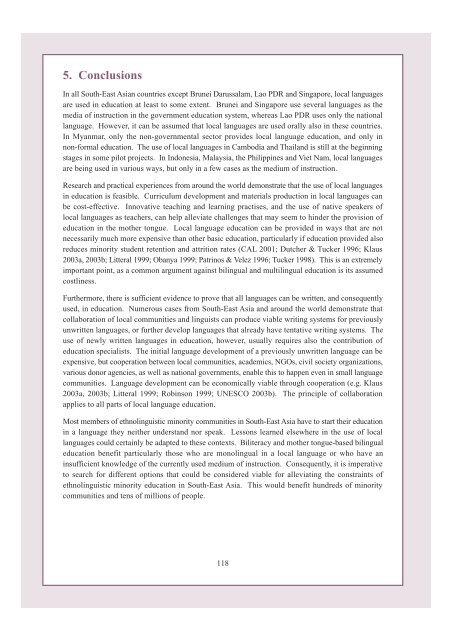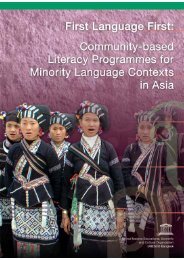Part II.pdf - MTB-MLE Network
Part II.pdf - MTB-MLE Network
Part II.pdf - MTB-MLE Network
Create successful ePaper yourself
Turn your PDF publications into a flip-book with our unique Google optimized e-Paper software.
5. Conclusions<br />
In all South-East Asian countries except Brunei Darussalam, Lao PDR and Singapore, local languages<br />
are used in education at least to some extent. Brunei and Singapore use several languages as the<br />
media of instruction in the government education system, whereas Lao PDR uses only the national<br />
language. However, it can be assumed that local languages are used orally also in these countries.<br />
In Myanmar, only the non-governmental sector provides local language education, and only in<br />
non-formal education. The use of local languages in Cambodia and Thailand is still at the beginning<br />
stages in some pilot projects. In Indonesia, Malaysia, the Philippines and Viet Nam, local languages<br />
are being used in various ways, but only in a few cases as the medium of instruction.<br />
Research and practical experiences from around the world demonstrate that the use of local languages<br />
in education is feasible. Curriculum development and materials production in local languages can<br />
be cost-effective. Innovative teaching and learning practises, and the use of native speakers of<br />
local languages as teachers, can help alleviate challenges that may seem to hinder the provision of<br />
education in the mother tongue. Local language education can be provided in ways that are not<br />
necessarily much more expensive than other basic education, particularly if education provided also<br />
reduces minority student retention and attrition rates (CAL 2001; Dutcher & Tucker 1996; Klaus<br />
2003a, 2003b; Litteral 1999; Obanya 1999; Patrinos & Velez 1996; Tucker 1998). This is an extremely<br />
important point, as a common argument against bilingual and multilingual education is its assumed<br />
costliness.<br />
Furthermore, there is sufficient evidence to prove that all languages can be written, and consequently<br />
used, in education. Numerous cases from South-East Asia and around the world demonstrate that<br />
collaboration of local communities and linguists can produce viable writing systems for previously<br />
unwritten languages, or further develop languages that already have tentative writing systems. The<br />
use of newly written languages in education, however, usually requires also the contribution of<br />
education specialists. The initial language development of a previously unwritten language can be<br />
expensive, but cooperation between local communities, academics, NGOs, civil society organizations,<br />
various donor agencies, as well as national governments, enable this to happen even in small language<br />
communities. Language development can be economically viable through cooperation (e.g. Klaus<br />
2003a, 2003b; Litteral 1999; Robinson 1999; UNESCO 2003b). The principle of collaboration<br />
applies to all parts of local language education.<br />
Most members of ethnolinguistic minority communities in South-East Asia have to start their education<br />
in a language they neither understand nor speak. Lessons learned elsewhere in the use of local<br />
languages could certainly be adapted to these contexts. Biliteracy and mother tongue-based bilingual<br />
education benefit particularly those who are monolingual in a local language or who have an<br />
insufficient knowledge of the currently used medium of instruction. Consequently, it is imperative<br />
to search for different options that could be considered viable for alleviating the constraints of<br />
ethnolinguistic minority education in South-East Asia. This would benefit hundreds of minority<br />
communities and tens of millions of people.<br />
118
















